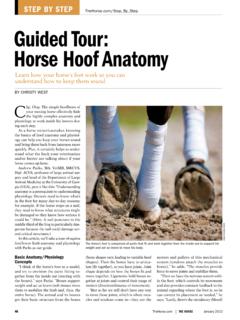Transcription of PRINCIPLES OF IMPROVISED OSIVE DEVICES
1 PRINCIPLES OF IMPROVISED OSIVE DEVICES A PALADIN PRESS BOOK PRINCIPLES of IMPROVISED Explosive DEVICES Copyright 1984 by Paladin Press ISBN 0-87364-288-0 Printed in the United States of America Published by Paladin Press, a division of Paladin Enterprises, Inc., Box 1307, Boulder, Colorado 80306, USA. (303) 443-7250 Direct inquiries and/or orders to the above address. All rights reserved. Except for use in a review, no portion of this book may be reproduced in any form without the express written permission of the publisher. Neither the author nor the publisher assumes any responsibility for the use or misuse of information contained in this book. CONTENTS INTRODUCTION .. iv I. PRINCIPLES OF IEDs .. 2. ACCESS AND RENDER SAFE PROCEDURES APPLYING IN AN EOD (IOD) INCIDENT .. 35 3. THE USE OF DETONATING CORD IN THE OPENING OF IEDs 57 4. USE OF THE SHOTGUN IN THE DISPOSAL OF IEDS 61 INTRODUCTION The purpose of this manual is twofold. First and foremost it is to inform those individuals involved in EOD work of additional methods that may be employed by both terrorists and EOD operators in their respective areas.
2 The second purpose is that of a dedication to the EOD operators of the Rhodesian Army. It was my good fortune to have served with them and learn with them from 1976-1978. I have not used the word "expert" but rather "operator." Our chief instructor, the late Captain Charles Small, maintained that there were no experts in EOD work, but those who were very careful and lucky might someday come close to that title. It is my sincere hope that the information imparted in the following pages will give the operators using it just a little more luck than they had before. M. J. DeForest For Charlie, Frans, A. J., Craig, and all unremembered. 1. PRINCIPLES OF IEDs List of Figures Introduction Explosive DEVICES Electrical Switches Chemical Switches Mechanical Switches Friction Switches Special Components Detonators and Accessories Explosives Incendiary DEVICES Switches Igniters Incendive Materials Explosive/Incendiary DEVICES Complete DEVICES 2 4 6 6 26 26 27 28 29 30 31 31 31 32 33 34 2 LIST OF FIGURES Figure Figure Basic lED Circuit 43 Bali-in-Tube Switch (Double)
3 2 Spring-Type Wooden Clothes Peg 44 Home-Made Mercury Switch 3 Misfired Nail Bomb with Clothes Peg 45 Commercial Mercury Switch 4 Book Device with Clothes Peg 46 Allways Switch 5 Clothes Peg Pull/Trip Switch 47 Trembler Switch 6 Clothes Peg Door Boobytrap 48 Pendulum Switch 7 Household Mousetrap 49 Relay 8 Bared Wire Switch 50 Simple Relay Circuit 9 Cache Boobytrap Switch 51 Double Interlocked Relays 10 Cache Boobytrap Switch 52 Reed Switch 11 A/Open Switch in Parcel 53 Solenoid and Contact Breaker Switch 12 Wire Loop on Battery 54 Doorbell Circuit 13 Toggle Switch and Pull-Wire 55 A/Probe Switch 14 Book Device with Foil Contacts 56 Clockwork Switch-Hand and Pin 15 Letter Bomb with Foil Contacts 57 Clockwork Switch-Hand and Wire 16 Bamboo Pole Device 58 Clockwork Switch-17 Tube and Ball Switch Alarm Winder and Wire 18 Knife Switch 59 Clockwork Switch-19 Clothes Peg Pressure Switch Alarm Winder and Microswitch 20 Mousetrap Pressure Switch 60 Clockwork Switch-21 Microswitch Alarm Winder and Toggle Switch 22 Pressure Mat 61 Clockwork Switch-Parkway Timer 23 Pressure Chamber Switch 62 Clockwork Switch-Clock and PO Fuze 24 Pressure Board Switch 63 Clockwork Switch-Clock and Hairpin 25 Doorbell Push Switch 64 Clockwork Switch-26 Wooden Wedge Electric Clock Long Delay 27 Pressurised Beer Keg Switch 65 Rodent Delay 28 Hacksaw Blades/Torch Bulb Switch 66 Water Drip Delay 29 Rocker Light Switch 67 Expanding Seed Delay 30 Suitcase Catch Switch 68 Clothes Peg Solder Delay 31 Thermos Flask Device 69 Clothes Peg, String, and Cigarette Delay 32 Clothes Peg Release Switch 70 Mousetrap Solder Delay 33 Suspended Device with Clothes Peg 71 Mousetrap.
4 String and Cigarette Delay 34 Clothes Peg Release Switch 72 Electronic Delayed Arming 35 Mousetrap ~elease Switch 73 Electronic Integrated Circuit Delay 36 Suspended D~ice with Mousetrap 74 Alka-Seltzer Electronic Delay 37 Mousetrap A pen Switch 75 'E' Cell 38 Microswitch A/Lift 76 Electrochemical Delay 39 A/Lift Block and Plunger 77 Temperature Sensitive Switch 40 Hinged Base Device 78 Smoke/Gas Sensitive Switch 41 Mousetrap A/Lift Switch 79 Acoustic Switch 42 Ball-in-Tube Switch (Single) 80 Light Sensitive Switch 3 Figure 81 Light Sensitive Switch 82 Infra-Red Sensitive Switch 83 X-Ray Sensitive Switch 84 Barometric Pressure Can Switch 85 Altimeter Switch 86 Alka-Seltzer Tablet Humidity Switch 87 Contact Plate Humidity Switch 88 Glass Tube/Contraceptive Chemical Switch 89 Table Tennis Ball Chemical Switch 90 Hand Grenade with Fly-Off Lever 91 Mousetrap Gun 92 Typical Service Release Switch 93 Cigarette Lighter Device 94 Sandpaper Flap Switch and Device 95 Clock Friction Switch 96 Needle in Detonator 97 Thyristor Configurations 98 Post Office Fuze 99 PO Fuze as Arming Device 100 FLN Electric Detonator 101 Igniter Safety Fuze Electric 102 Powder Fuze 5 gr.
5 103 Broken Torch Bulb Igniter 104 Gas Lighter Element 105 Hot Wire Igniter 106 Double Anti-Lift Switch Device 107 Doorbell Collapsing Circuit Device 108 Complex Time/ Anti-Handling Device 4 PRINCIPLES OF IMPROVISED EXPLOSIVE DEVICES INTRODUCTION I. For many years RAOC technical ammunition personnel have been involved in the neutralization of IMPROVISED Explosives DEVICES (lED), both in the United Kingdom and overseas. 2. From this experience, and from that of various foreign agencies, a large amount of information on the PRINCIPLES of terrorist device construction and operation has been obtained. 3. A high proportion of DEVICES encountered are of relatively simple design, but there is evidence of a drift towards a greater degree of sophistication. AIM 4. The aim of this precis is to describe the design PRINCIPLES of terrorist DEVICES with emphasis on the methods of triggering and/or switching which may be encountered. CATEGORIES OF DEVICE 5. There are four categories of device used by terrorists.
6 These are: a. Non-Explosive Anti-Personnel DEVICES Intended for local effect against one or more persons, these contain no explosives, but depend on the action of acids, chemicals, or sharp sections of materials such as broken razor blades, steel fragments, glass slivers, pointed stakes, etc., arranged so that they are projected by some initiating action. They are not necessarily contained in packages, but may also be found in the ground, on trees, etc. This category of device is not an lED and is not dealt with in this precis. b. Explosive DEVICES Normally designed to effect maximum injury to personnel and/or destructive damage to property, 7he onsist of: Initiation system-may be manual, chemical, mechanical or electrical. ii. Detonator. iii. Main explosive charge. c. Incendiary DEVICES These are normally designed to destroy property by burning and consist of: 5 i. Initiation System-May be manual, chemical, mechanical or electrical. ii. Detonator.
7 Not usually contained. iii. Explosive charge. iv. Incendiary material. d. Explosive/Incendiary DEVICES These are multi-purpose DEVICES designed to cause injury to personnel, and damage to property by a combination of blast and burning. They consist of: i. Initiation System-May be manual, chemical, mechanical or electrical. ii. Detonator. iii. Explosive charge. iv. Incendiary material. 6. IEDs are manufactured with the intention that they are sent to, or deposited in, locations where they can function at the appropriate time with the desired effect. Functioning can be triggered by one, or more, of the following actions: a. When the device is handled or disturbed. These are referred to as anti-handling actions. b. At a predetermined time. These are referred to as delay or time actions. c. At the terrorist's command. These are referred to as command actions. d. By a change in ambient conditions. 7. The list of DEVICES and components described in this precis is not exhaustive and personnel engaged in render safe operations must be prepared to deal with other types.
8 8. For ease of reference, all initiation actions, electrical or otherwise, are referred to as switches. 9. It is important to remember two facts: a. A device may contain more than one switch or firing circuit. b. The flWitch is not necessarily in the device. It may be remotely connected by some means ( rtric cable, detonating cord, etc.). 6 PART 1 -EXPLOSIVE DEVICES INITIATION 10. The initiation systems of explosive DEVICES may be electrical, chemical, mechanical, friction, or ignition by the terrorist. SECTION 1 -ELECTRICAL SWITCHES 11. The most common system of initiation is the electrical method using some form of dry battery, since these are both efficient and readily available. 12. Initiation from main power supplies is not popular with the terrorist as it limits the tactical use of DEVICES , but if the situation is suitable, main power supplies may well be utilised. 13. The basic electrical circuit of an explosive device is shown in Figure 1.
9 From this diagram it can be seen that the flow of current from the power supply to the detonator is controlled by: a. An Arming Switch Whilst open, ensures safety to the terrorist. Closed by some means after dispatch or placing of the device. b. A Firing Switch The final link in the circuit. When closed, the initiating current is passed to the detonator. 14. The functions of arming and firing within a device may be carried out by several components or by one component only. 15. From the functional aspect, electrical switches ca11 be classified into four groups as shown below: a. Anti-Handling Pull Pressure Release Lift Tilt Trembler/Pendulum ~sing Circuit Thermal Anti-Probe b. Delay Clockwork Thermal Collapsing Circuit Electronic Electro-Chemical Material Fatigue Chemical Water Drip Expanding Seed c. Ambient Conditions Temperature Sensitive Smoke/Gas Sensitive Metal Sensitive Acoustic Proximity Transient Sensitive Light/Infra-Red Sensitive X-Ray Sensitive Barometric Humidity d.
10 Command FM Transmission Command Wire Radio Control Ultrasonic Control Infra-Red Beam Radar Beam Post Office System 7 16. Certain electrical components used in DEVICES cannot be specifically classified. These are dealt with as individual components in Part 1, Section 5. PULL 17. The following switches and switching arrangements utilise a pulling movement: a. Spring-Type Wooden Clothes Peg (Figure 2) An electric lead is connected to the inside face of each jaw by means of a drawing pin, the switch being kept in the open position by a piece of insulating material. When the insulator is removed, the spring forces the jaws to close and the circuit is completed. Some examples of use are: 8 i. Simple arming switch in many DEVICES . ii. Misfired Nail Bomb (Figure 3) A piece of burnt safety fuze is inserted between the jaws as an insulator, and when withdrawn, allows device to function. iii. Book Device (Figure 4) Two clothes pegs are connected in parallel, one to act independently of the other if either the back or front cover of the book is opened.








